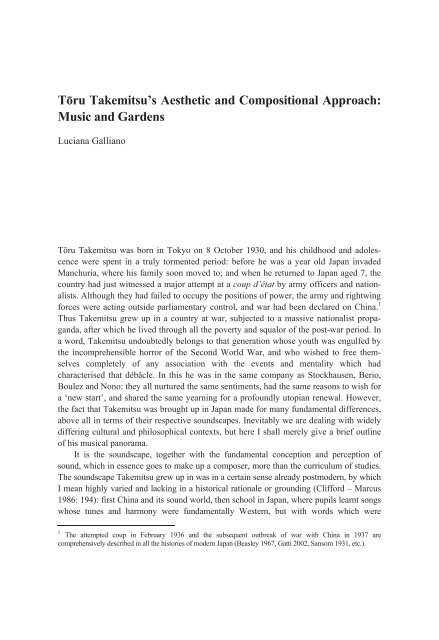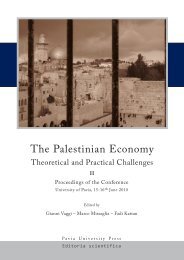Musica che affronta il silenzio - Scritti su Toru Takemitsu - Pavia ...
Musica che affronta il silenzio - Scritti su Toru Takemitsu - Pavia ...
Musica che affronta il silenzio - Scritti su Toru Takemitsu - Pavia ...
Create successful ePaper yourself
Turn your PDF publications into a flip-book with our unique Google optimized e-Paper software.
Tru Takemit<strong>su</strong>’s Aesthetic and Compositional Approach:<br />
Music and Gardens<br />
Luciana Galliano<br />
Tru Takemit<strong>su</strong> was born in Tokyo on 8 October 1930, and his ch<strong>il</strong>dhood and adolescence<br />
were spent in a truly tormented period: before he was a year old Japan invaded<br />
Manchuria, where his fam<strong>il</strong>y soon moved to; and when he returned to Japan aged 7, the<br />
country had just witnessed a major attempt at a coup d’état by army officers and nationalists.<br />
Although they had fa<strong>il</strong>ed to occupy the positions of power, the army and rightwing<br />
forces were acting outside parliamentary control, and war had been declared on China. 1<br />
Thus Takemit<strong>su</strong> grew up in a country at war, <strong>su</strong>bjected to a massive nationalist propaganda,<br />
after which he lived through all the poverty and squalor of the post-war period. In<br />
a word, Takemit<strong>su</strong> undoubtedly belongs to that generation whose youth was engulfed by<br />
the incomprehensible horror of the Second World War, and who wished to free themselves<br />
completely of any association with the events and mentality which had<br />
characterised that débâcle. In this he was in the same company as Stockhausen, Berio,<br />
Boulez and Nono: they all nurtured the same sentiments, had the same reasons to wish for<br />
a ‘new start’, and shared the same yearning for a profoundly utopian renewal. However,<br />
the fact that Takemit<strong>su</strong> was brought up in Japan made for many fundamental differences,<br />
above all in terms of their respective soundscapes. Inevitably we are dealing with widely<br />
differing cultural and ph<strong>il</strong>osophical contexts, but here I shall merely give a brief outline<br />
of his musical panorama.<br />
It is the soundscape, together with the fundamental conception and perception of<br />
sound, which in essence goes to make up a composer, more than the curriculum of studies.<br />
The soundscape Takemit<strong>su</strong> grew up in was in a certain sense already postmodern, by which<br />
I mean highly varied and lacking in a historical rationale or grounding (Clifford – Marcus<br />
1986: 194): first China and its sound world, then school in Japan, where pup<strong>il</strong>s learnt songs<br />
whose tunes and harmony were fundamentally Western, but with words which were<br />
1 The attempted coup in February 1936 and the <strong>su</strong>bsequent outbreak of war with China in 1937 are<br />
comprehensively described in all the histories of modern Japan (Beasley 1967, Gatti 2002, Sansom 1931, etc.).

















